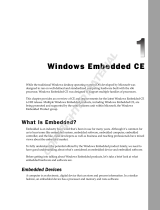
www.digi.com
7
Using the HTML-to-C Compiler
The next step incorporates the Web content into the HTTP server. Commercial Web
servers installed on UNIX or Windows NT systems have storage disks with large file
systems. Incorporating Web content is fairly routine because pages and images are
added to an existing directory, making the files Web-accessible. Embedded devices
normally have read-only memory (ROM) without a file system. The Web content in
such cases must be incorporated directly into the embedded device application
stored in ROM.
When you write HTML from scratch, you develop pages by adding HTML markup tags
to the text content, using either a text editor or Web authoring tool. You can add the
same pages to an embedded device by writing application code to physically return
an HTML page. The page is stored in a large character buffer in the device and
returned through a network API such as sockets.
As tools for generating HTML pages become more advanced, webmasters do not
generate HTML pages by hand. Web authoring tools are more efficient and reduce
the amount of typing needed in markup tags.
Static and dynamic content and forms processing
Embedded devices must be able to incorporate static content, dynamic content,
and forms processing into the embedded HTTP server source code.
The HTML-to-C compiler automatically converts Web content into application
source code:
Static pages are converted into the necessary program calls to send back
HTML, image, and applet content that does not change over time. Nothing
needs to be added after the page is converted. Static pages are a small part of
the content provided by a Web server.
Dynamic content, which changes over time, is necessary for status reporting.
This type of content has proprietary non-HTML markup tags inserted with an
HTML editor into the HTML source code. The HTML-to-C compiler recognizes
these tags and produces shell routines and calls to the routines in the
application source code. The embedded designer is then responsible for
implementing the routines so that the appropriate dynamic content is
returned when the routines are called.
Forms processing, which accepts user input and acts on it, also is necessary
for making configuration changes in an embedded device.





















